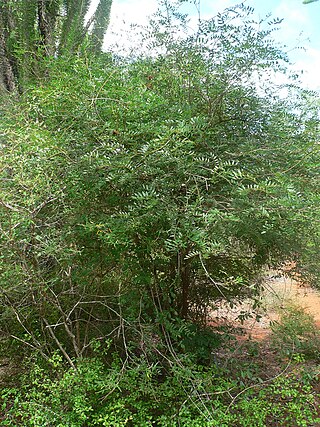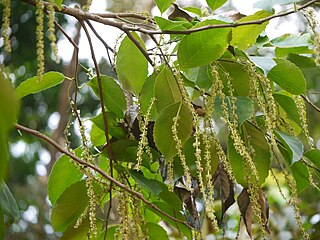
In the botanical classification of plants, Aeridinae Pfitzer is a subtribe of the tribe Vandeae whose representatives all have a monopodial growth habit and do not possess pseudobulbs.

Cordyla is a genus of flowering plants in the family Fabaceae. It includes seven species native to sub-Saharan Africa, ranging across northern Africa from Senegal to Somalia, and through eastern Africa from Sudan to KwaZulu-Natal, including Madagascar.

Linderniaceae is a family of flowering plants in the order Lamiales, which consists of about 25 genera and 265 species occurring worldwide. Vandellia micrantha is eaten in Laos, but tastes bitter. Best known are the wishbone flowers Torenia fournieri and Torenia thouarsii, which are used as bedding plants, especially in the tropics. Micranthemum is sold as an aquarium plant when it is called 'baby tears'.

Homalium is a genus of plants in the family Salicaceae.

Litsea glutinosa is a rainforest tree in the laurel family, Lauraceae. Common names include soft bollygum, bolly beech, Bollywood, bollygum, brown bollygum, brown Bollywood, sycamore and brown beech.

Aidia cochinchinensis is the type species of the genus Aidia, in the family Rubiaceae. Aidia cochinchinensis is native to south-central China, including Hainan, and Vietnam.
Thilachium is a genus of flowering plants belonging to the family Capparaceae.
Antherotoma is a genus of flowering plants belonging to the family Melastomataceae.

Argyrella is a genus of flowering plants belonging to the family Melastomataceae. Its native range is Africa.
Cailliella is a genus of flowering plants belonging to the family Melastomataceae.
Calvoa is a genus of flowering plants belonging to the family Melastomataceae.
Cincinnobotrys is a genus of flowering plants belonging to the family Melastomataceae.
Diplolophium is a genus of flowering plants belonging to the family Apiaceae.
Solena is a genus of flowering plants belonging to the family Cucurbitaceae.
Maclaudia is a monotypic genus of flowering plants belonging to the family Apocynaceae. It only contains one known species, Maclaudia felixii Venter & R.L.Verh.
Dicellandra is a genus of flowering plants belonging to the family Melastomataceae.
Melastomastrum is a genus of flowering plants belonging to the family Melastomataceae.
Linariopsis is a genus of flowering plants belonging to the family Pedaliaceae.
Ptelidium is a genus of flowering plants belonging to the family Celastraceae.

Heterotis is a genus of flowering plants belonging to the family Melastomataceae.







